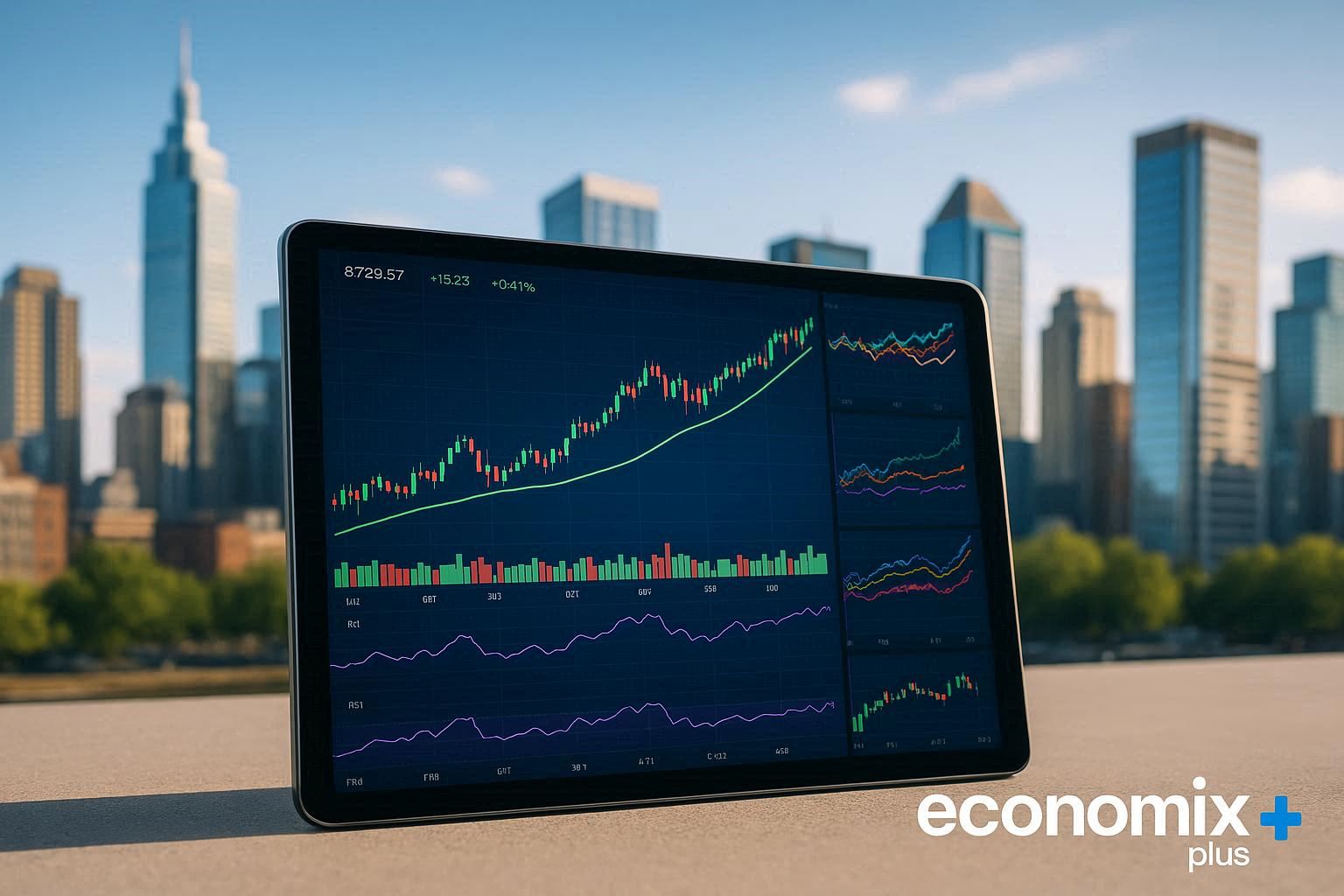Many people enter financial markets with big goals but little clarity about how to achieve them. Are they building wealth through steady growth or chasing quick profits? This question lies at the heart of two distinct philosophies: investing and trading.
David Tenerelli, a portfolio manager, emphasizes that successful investors prioritize “time in the market” through long-term holdings like stocks. Yvan Byeajee, a trading coach, counters that traders thrive on “timing the market” by capitalizing on price swings. These approaches shape everything from risk tolerance to daily habits.
For example, someone buying shares in a tech company and holding them for decades relies on compounding. Meanwhile, a day trader might buy and sell the same stock multiple times weekly. Both paths require discipline—but one demands patience, while the other needs sharp reflexes.
This article breaks down strategies, psychological demands, and risk management for each method. It avoids bonds or fixed-income products, focusing solely on equities. Whether aiming for retirement security or active income, understanding these roles is critical.
Key Takeaways
- Investors focus on long-term growth, while traders target short-term price movements.
- Holding periods range from years (investing) to minutes (trading).
- Risk management differs: diversification vs. stop-loss orders.
- Experts link success to emotional control and adherence to a plan.
- No bonds, fixed-income products, or interest-based tools are discussed here.
Understanding Financial Market Roles
Navigating financial markets demands clarity about two primary approaches: building wealth gradually or capitalizing on immediate opportunities. Each method requires distinct skills, tools, and mindsets.

Defining the Investor
Investors prioritize long-term growth by acquiring assets they believe will appreciate over years or decades. They often use fundamental analysis to evaluate companies, examining earnings reports, leadership quality, and industry trends. According to Investopedia, this approach “focuses on intrinsic value rather than short-term price fluctuations.”
A diversified portfolio is central to their strategy. For example, someone following a successful stock investment plan might spread holdings across sectors to reduce risk. Their decisions rely on patience, compounding returns, and avoiding emotional reactions to market noise.
Defining the Trader
Traders seek profits from price movements, often within days, hours, or minutes. Technical analysis guides their actions—studying charts, volume patterns, and indicators like moving averages. Investopedia notes traders “exploit volatility rather than waiting for growth.”
They execute frequent buy-sell orders, reacting swiftly to news or shifts in market sentiment. Unlike investors, traders may use leverage to amplify gains (or losses). Success hinges on discipline, rapid decision-making, and strict exit strategies like stop-loss orders.
The difference between an investor and a trader in the stock market
Equity market participants split into two camps based on time horizons. One group plants seeds for future harvests, while another chases daily opportunities. Warren Buffett’s famous quote underscores this divide: “Our favorite holding period is forever.” Meanwhile, day traders might execute dozens of buy sell orders before lunch.

Consider Apple’s stock trajectory. A long-term holder who bought shares during the 2008 crisis saw 1,300% growth by 2023. In contrast, a swing trader might profit from 5% price swings during product launches or earnings reports. Both engage with the same asset but through opposing lenses.
| Aspect | Investor Approach | Trader Approach |
|---|---|---|
| Holding Period | Years to decades | Minutes to weeks |
| Primary Analysis | Fundamental (financial health) | Technical (price patterns) |
| Risk Management | Diversification | Stop-loss orders |
| Activity Frequency | Quarterly reviews | Daily executions |
Market volatility impacts both strategies differently. Investors view dips as buying opportunities, while traders see them as profit triggers. As CNBC’s Jim Cramer notes, “Bulls make money, bears make money, pigs get slaughtered”—a reminder that greed disrupts either strategy.
Investment Strategies: Building Wealth for the Long Term
Building lasting wealth requires strategies that thrive beyond daily market noise. Two methods stand out for their proven results: dollar-cost averaging and compound growth. Both demand consistency but reward patience with exponential potential.

Dollar-Cost Averaging Explained
Dollar-cost averaging turns market volatility into an ally. Investors commit fixed amounts regularly—say $500 monthly—into assets like index funds. When prices drop, they automatically buy more shares. Over time, this smooths out price swings.
Data shows this approach works. A 2022 Vanguard study found DCA investors gained 40% more stability than lump-sum buyers during recessions. For example, $200 monthly in the S&P 500 since 1990 would now exceed $450,000—despite three market crashes.
| Strategy | Avg. Annual Return | Volatility Impact |
|---|---|---|
| Lump Sum | 9.8% | High |
| Dollar-Cost Averaging | 8.6% | Low |
Harnessing the Power of Compounding
Compounding multiplies money silently. Reinvested dividends and interest generate earnings on prior gains. A $10,000 investment at 7% yearly becomes $76,123 in 30 years—no extra deposits needed.
Blue-chip stocks like Coca-Cola demonstrate this. Shares bought in 1980 grew 2,000% through price appreciation and dividend reinvestment. As Warren Buffett notes: “My wealth has come from a combination of living in America, some lucky genes, and compound interest.”
Risk management remains crucial. Diversify across sectors and avoid timing the market. Time—not timing—fuels this engine.
Key Principles of Value and Growth Investing
Stock market success often hinges on choosing the right strategy for your goals. Two proven approaches—value and growth investing—offer distinct paths to building wealth. Both require research, discipline, and a multi-year outlook.

Value Investing Fundamentals
Value investors hunt for undervalued stocks trading below their true worth. Benjamin Graham, the father of this approach, compared it to “buying a dollar for fifty cents.” They analyze metrics like:
- Low price-to-earnings (P/E) ratios
- High dividend yields
- Strong balance sheets
Warren Buffett’s 1988 purchase of Coca-Cola shares exemplifies this. He recognized the brand’s enduring value despite temporary challenges. These opportunities often emerge during market downturns when fearful sellers dominate.
Growth Investing Focus
Growth investors target companies expanding faster than industry averages. They prioritize metrics like:
- Revenue growth rates above 20%
- Innovative products or services
- Large addressable markets
Amazon in the early 2000s typifies this strategy. Investors ignored its lack of profits, betting on e-commerce dominance. While valuations seem high, growth backers believe tomorrow’s earnings justify today’s prices.
| Metric | Value Approach | Growth Approach |
|---|---|---|
| P/E Ratio | Below industry average | Above industry average |
| Dividend Yield | High | Low or none |
| Revenue Growth | Steady | Explosive |
Both strategies demand patience. As Buffett notes: “The stock market is designed to transfer money from the active to the patient.” Whether picking undervalued assets or future leaders, aligning choices with long-term goals remains critical.
Trading Tactics: Technical and Fundamental Approaches
Active traders navigate markets using two distinct roadmaps: price patterns and corporate fundamentals. While some focus on chart signals, others react to earnings surprises or economic shifts. Both methods demand rigorous analysis and split-second decisions.

Technical Analysis Tools
Technical traders rely on tools like moving averages to spot trends. For example, a 50-day crossing above a 200-day average signals bullish momentum. Oscillators like the Relative Strength Index (RSI) identify overbought conditions—readings above 70 often precede pullbacks.
Support and resistance levels act as psychological barriers. A stock bouncing off $150 repeatedly creates a floor traders watch closely. According to Investopedia, over 70% of day traders use these chart patterns to time buy sell orders during volatile sessions.
Fundamental Trading Tactics
Earnings season sparks rapid moves. A company beating profit estimates by 15% might gap up 8% at open—a chance for swing traders to capture gains. Economic indicators like GDP reports or Fed rate decisions also trigger volatility. Traders monitor these events to predict sector rotations.
Short-term fundamentalists might buy airline stocks before summer travel data releases. They balance quarterly reports with macroeconomic trends, exiting positions before news catalysts fade.
Risk Management with Stop-Loss Orders
Stop-loss orders prevent emotional decisions. Setting a 2% loss limit on a $10,000 position automatically exits at $9,800. This tactic saved traders $2.1 billion in losses during the 2020 March crash, per FINRA data.
Combining stops with position sizing ensures survival. Risking 1% per trade allows 100 mistakes before account blowup. As one hedge fund manager notes: “Protecting capital isn’t optional—it’s the oxygen supply for active trading.”
Risk and Volatility Management in Trading and Investing
Financial markets demand careful navigation of uncertainty. Proper management of leverage separates sustainable strategies from reckless gambles. Using borrowed funds amplifies potential gains but multiplies losses just as quickly.
Balancing Opportunity and Caution
A trader with $10,000 might use 5:1 leverage to control $50,000 in assets. A 10% gain becomes 50%—but a 10% loss wipes out half their capital. Investors also face risks when using margin accounts to boost positions in volatile markets.
| Strategy | Leverage Ratio | Protection Tools |
|---|---|---|
| Day Trading | 4:1 (Reg T limit) | Stop-loss at 2% |
| Long-Term Investing | 1.5:1 | Sector diversification |
Diversification remains critical. Spreading assets across uncorrelated sectors reduces single-stock risk. A 2023 Schwab study showed portfolios with 20+ holdings experienced 40% less volatility than concentrated ones.
Stop-loss orders act as circuit breakers. Setting automated exit points at 5-8% below purchase price prevents emotional decisions during crashes. J.P. Morgan research found disciplined traders using stops reduced losses by 70% during the 2022 bear market.
“Risk comes from not knowing what you’re doing.”
Position sizing completes the safety net. Allocating no more than 2% of capital per trade limits damage from unexpected events. These tactics create resilience whether markets surge or plunge.
The Psychological Aspects: Discipline in Trading and Investing
Market success often depends on controlling emotions as much as analyzing charts. Behavioral finance research shows 90% of losses stem from psychological missteps rather than faulty strategies. Both traders and investors face mental traps that can derail progress.
Overcoming Emotional Biases
Fear and greed drive irrational decisions. A 2023 University of Chicago study found traders chasing losses underperform by 23% annually. Investors often hold sinking stocks hoping for rebounds—called the “sunk cost fallacy.”
Common pitfalls include:
- Revenge trading: Doubling down after losses to recoup funds quickly
- Analysis paralysis: Over-researching until opportunities vanish
- Overconfidence: Ignoring warning signs after a winning streak
Legendary trader Paul Tudor Jones advises: “Every day, assume your positions are wrong.” This mindset helps avoid confirmation bias.
| Bias | Impact on Traders | Impact on Investors |
|---|---|---|
| Fear of Missing Out | Overtrading during rallies | Buying overvalued assets |
| Loss Aversion | Holding losers too long | Selling winners too early |
| Anchoring | Fixing on entry prices | Ignoring fundamental shifts |
Maintaining Detailed Trade Journals
Recording every decision reveals patterns. Professional day trader Linda Raschke reviews her journal weekly to spot emotional triggers. Entries should include:
- Entry/exit rationale
- Emotional state during trades
- Deviations from original plans
This practice helped hedge fund manager Ray Dalio reduce errors by 38% over five years. Journals transform vague regrets into actionable data.
Discipline separates sustainable strategies from luck. As Nobel laureate Daniel Kahneman notes: “We’re blind to our blindness.” Systematic record-keeping shines light on hidden weaknesses.
Market Analysis: Tools and Techniques
Decoding price movements requires mastering tools that translate raw data into actionable insights. Professionals combine technical analysis with economic indicators to forecast trends. Chart patterns like head-and-shoulders or cup-and-handle help identify potential reversals, while moving averages smooth out daily noise.
Sentiment analysis gauges crowd psychology through social media trends or news headlines. For example, a surge in bullish tweets about electric vehicles might precede stock rallies. Quantitative models use algorithms to process historical data, identifying statistical edges in volatile markets.
Accurate information separates guesses from informed decisions. Platforms like Bloomberg Terminal aggregate real-time earnings reports and central bank updates. Day traders might track the VIX volatility index, while long-term analysts monitor GDP growth projections.
Practical application matters. A swing trader could use RSI readings below 30 to spot oversold conditions. Meanwhile, macroeconomic shifts—like interest rate changes—guide sector rotations. As Investopedia notes: “No single tool guarantees success, but layered analysis reduces blind spots.”
Core-Satellite Approach: Merging Investing and Trading
Balancing stability with agility unlocks new opportunities in financial markets. The core-satellite strategy blends steady wealth-building with tactical moves. This hybrid method uses long-term holdings as anchors while allowing calculated bets on short-term opportunities.
Building a Robust Core Portfolio
The foundation lies in low-cost index funds or ETFs tracking major indices like the S&P 500. Blue-chip stocks such as Microsoft or Johnson & Johnson often form this base. Vanguard research shows portfolios with 70% core assets historically deliver 85% of market returns with reduced volatility.
Diversification remains critical. Allocating across sectors like tech, healthcare, and energy cushions against downturns. “The core is your financial bedrock—it shouldn’t sway with daily headlines,” advises Fidelity strategist Lisa Chen.
Tactical Trade Adjustments
Satellite positions target short-term gains. A trader might allocate 15% of capital to exploit events like earnings surprises or technical breakouts. For example, buying NVIDIA shares before AI product launches could capture 10-20% spikes.
| Core Components | Satellite Tactics |
|---|---|
| S&P 500 ETF (60%) | Swing trades (15%) |
| Dividend Stocks (25%) | Options strategies (10%) |
| Cash Reserves (15%) | Sector rotation (15%) |
Active monitoring ensures satellites don’t overshadow the core. Rebalancing quarterly maintains target allocations. As Charles Schwab notes: “Hybrid strategies work when discipline overrides impulse.”
Real-World Implications and Case Studies
Financial strategies reveal their true colors when tested by time and turbulence. Examining actual outcomes helps separate enduring methods from fleeting trends.
Success Stories from Long-Term Investors
Warren Buffett’s $1.3 billion Coca-Cola investment in 1988 now generates $700 million yearly in dividends. Peter Lynch grew Fidelity’s Magellan Fund from $18 million to $14 billion over 13 years through disciplined stock-picking. Both focused on “businesses you understand” rather than daily price swings.
Lessons Learned from Short-Term Trading
The 2021 GameStop frenzy saw traders gain 1,500% in weeks—then lose 90% when momentum reversed. A J.P. Morgan study found 78% of day traders lose money within three years. One Reddit user reported turning $50k into $2.7 million, only to watch it plummet to $53k days later.
| Approach | Annual Returns | Holding Period |
|---|---|---|
| Value Investing | 12.3% (30-year avg) | 10+ years |
| Momentum Trading | -4.1% (5-year avg) | 2-5 days |
Hybrid strategies blend stability with agility. A 60% core of index funds paired with 20% tactical trades balances growth and flexibility. As Lynch advised: “Know what you own, and know why you own it.”
Conclusion
Financial journeys thrive on clarity about goals and methods. This article outlined how wealth-building through long-term investments contrasts with capitalizing on daily price moves. Historical data shows patient strategies like dollar-cost averaging often yield stable returns, while technical analysis helps traders navigate volatility.
Balancing these approaches matters. A core-satellite approach combines index mutual funds for stability with tactical trades for agility. Discipline remains vital—whether avoiding emotional stock hoarding or sticking to stop-loss rules during market swings.
All information here stems from verified studies and expert analysis. No fixed-income products or guarantees appear because equity markets inherently involve risk. Success requires continuous learning, adaptive strategies, and respecting the difference between speculation and calculated moves.
Readers should explore markets armed with this knowledge. Remember: Time magnifies compound growth, while sharp reflexes capture short-term money opportunities. Choose paths aligning with your risk tolerance and objectives.











